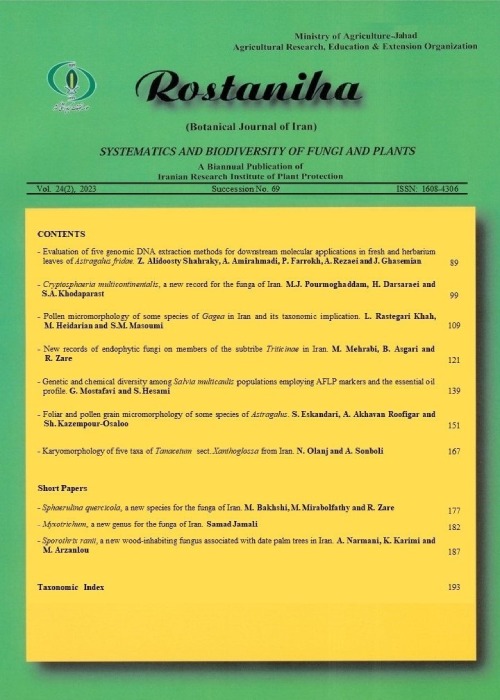Geopora cooperi, a new hypogeous ascomycete record for Iran mycobiota
Author(s):
Article Type:
Research/Original Article (دارای رتبه معتبر)
Abstract:
The Pezizales are an order of the subphylum Pezizomycotina within the phylum Ascomycota. Members of this order are characterized by unitunicate asci that typically open by rupturing to form a terminal or eccentric lid or operculum (Hansen & Pfister 2006). Of the 1638 Pezizales species known so far, Geopora Harkn. (Pyronemataceae) is represented by 23 species (Kirk et al. 2008). Geopora spp. are characterized by entirely or partially hypogeous, globular, semi-globular or cup-shaped ascocarps, whitish, greyish or yellowish grey hymenium, cylindrical, 8-spored and operculate asci, generally bifurcate, septate and hyaline paraphyses, ellipsoid, smooth ascospores mostly with one or two larger oil drops and some smaller oil drops (Tamm et al. 2010, Perić & Perić 2011). The members of the Geopora spp. are widely distributed in the Northern Hemisphere. Many researchers have reported Geopora species in North America, central, north, south and southeast Europe, and the Middle East (Tamm et al. 2010, Ashraf & Khalid 2012, Guo et al. 2019, Saba et al. 2019, Uzun & Kaya 2019). Saber & Pegler reportedthe presence of G. arenicola (Lév.) Kers in Iran as Sepultaria arenicola (Ershad 2009). In this study, two specimens of G. cooperi associated with Pinus nigra were collected in Khorassan Razavi province (Iran) in 2020 (Fig. 1a) with the following characteristics: Ascomata 50–55 mm in diameter, globose, subglobose to oblong, irregularly convoluted, peridium dark brown and covered with light brown hairs, gleba white to pinkish-white, highly convoluted, convolutions close but separate (Fig. 1b, c). Hymenium 200–250 μm thick. Asci 180–270(215) × 15–22(16) μm, cylindrical, 8-spored, non-amyloid and tapering at the base (Fig. 1d, e). Paraphyses cylindrical, septate, swollen at the tips, nearly of the same level as ascus, enlarged at the apex up to 11.5 μm (Fig. 1f). Ascospores 18–27(23) × 13–17(14) μm, smooth, hyaline, broadly elliptical, thin-walled, generally with a large central guttule (Fig. 1g, h). Ectal excipulum 120 μm, 4–5 cells thick, dark brown, textura globulosa,cells oblong to circular in section, smooth, walls thick and dark brown, 24–40 × 18–27 μm, cells on the outside darker than the inner cells (Fig. 1i). Excipular hairs hyphae-like, branched, very long to 1000 μm, 5–17 μm wide, blunt at the tips and dark walls (Fig. 1j). All these characteristics were consistent with other authors’ descriptions for G. cooperi (Tamm et al. 2010, Guo et al. 2019).While Geopora cooperi isconsidered as a very rare species by Perić & Perić (2011), itwas widely reported from Europe (Austria, Sweden, Norway, Denmark, Switzerland, Spain, and Italy) by Nannfeldt (1946), Moser (1963), Burdsall (1968), Soleilhac (1972), Ortega et al. (1981), Moreno et al. (1991), and Montecchi & Dal Forno (1995). This species is hereby reported new to the mycobiota of Iran. The mycorrhizal association of Geopora species with various conifers and deciduous trees such as Pinus ponderosa Lawson & Lawson (Fujimura et al. 2005), Pinus edulis Engelm., Cercocarpus ledifolius Nutt., Salix linearistipularis (Franch.) K. S. Hao, Quercus garryana Douglas ex Hook. (Frank et al. 2009), Quercus douglasii Hook., and Arn. (Smith et al. 2006), Picea abies (L.) Karst.(Tedersoo et al. 2006), Epipactis atrorubens (Hoffm.) Besser. (Shefferson et al. 2008), Abies grandis (Dougl.) Lindl., Cedrus spp., and Populus spp. (Tamm et al. 2010) have been confirmed by molecular techniques. Fujimura et al. (2005) have reported G. cooperi form mycorrhiza with Pinus ponderosa. Tedersoo et al. (2006) have identified ectomycorrhizal Geopora spp. on root tips both in coniferous and deciduous woodlands. They also have found Geopora spp. occurred in various early- and late-successional woodlands in acidic to alkaline forest soils, in addition to cinder and burnt soils. Association of G. cooperi with P. nigra, has been previously reported by Burdsall (1968) from the USA. Specimen examined: Iran: Khorassan Razavi province, under Pinus nigra, solitary, on ground, 24 July 2020 (IRAN 16696F).
Language:
English
Published:
Botanical Journal of Iran, Volume:21 Issue: 2, 2021
Pages:
292 to 295
magiran.com/p2221122
دانلود و مطالعه متن این مقاله با یکی از روشهای زیر امکان پذیر است:
اشتراک شخصی
با عضویت و پرداخت آنلاین حق اشتراک یکساله به مبلغ 1,390,000ريال میتوانید 70 عنوان مطلب دانلود کنید!
اشتراک سازمانی
به کتابخانه دانشگاه یا محل کار خود پیشنهاد کنید تا اشتراک سازمانی این پایگاه را برای دسترسی نامحدود همه کاربران به متن مطالب تهیه نمایند!
توجه!
- حق عضویت دریافتی صرف حمایت از نشریات عضو و نگهداری، تکمیل و توسعه مگیران میشود.
- پرداخت حق اشتراک و دانلود مقالات اجازه بازنشر آن در سایر رسانههای چاپی و دیجیتال را به کاربر نمیدهد.
In order to view content subscription is required
Personal subscription
Subscribe magiran.com for 70 € euros via PayPal and download 70 articles during a year.
Organization subscription
Please contact us to subscribe your university or library for unlimited access!



